2021.06.03.9
Files > Volume 6 > Vol 6 No 3 2021
INVESTIGATION / RESEARCH
Usage of Cicer Arietinum as a local and eco-friendly natural coagulant in sewage treatment and its ability to increase the formation of floc process.
Amera Marey Mohammed Hassanien (A.Marey)
Available from http://dx.doi.org/10.21931/RB/2021.06.03.9
ABSTRACT
Cicer Arietinum (CA) or chickpea seeds were used as a local natural coagulant, cheap and cultivable which available in Egypt that can be used to reduce turbidity from wastewater, especially sewage water instead of chemical coagulant that causes different diseases like intestinal constipation, loss of memory, convulsions, so this paper represents the use of chickpea as a natural coagulant and eco-friendly in the environment because it assumed to be safe for the human health and efficient in sewage treatment 6, So the researchers advices now to use natural coagulant as coagulant aids which has a higher ability to raise the consistency of floc and prevent of the coagulation operation. The optimum removal conditions that applied on the research were temperature =250C, pH= 3, Contact time=120 min, agitation speed for 2 minutes =80 rpm (rapid mixing), (CA) dosage is 90 mg/L, and (95.89%) turbidity reduction was achieved on the studied area.
Keywords: Turbidity, Cicer Arietinum, Chickpea, Natural Coagulant
INTRODUCTION
Water is the main element for life on the earth's surface; turbidity is a handy indicator for water quality so, there are new techniques for sewage and water treatment, but the coagulation/flocculation method is still the essential process for treatment and turbidity removal from water. Nowadays, natural coagulants are becoming better for treatment than other organic and inorganic coagulants like Alum and polyacrylamide, to reduce the human diseases and no human health danger also it is minimal expensive than the traditional chemicals.
The history of natural coagulants' utilization is extended, For more than 2000 years in India, Africa, and China as operative coagulants for turbidity water elevation. They are perhaps produced from plant seeds, leaves, and roots 14. Many operative coagulants from plant origin have been specified: Nirmali, Okra, red bean, Sugar and red maize, Moringa oleifera, Cactus latifera, and seed powder of Prosopis juliflora 7,8,19. Sewage / Wastewater recognized as an aggregation of water holding wastes from sewage is organic to consists of carbon compositions like human waste, paper, vegetable matter residences, institutions, commercial and industrial factories with groundwater, surface water, and stormwater probably exist 5. Sewage consists of 99.9% water and 0.1% solids, etc.; even after 1990, to increase scientific knowledge and a developed information base, wastewater treatment has initiated to focus on the health-related toxic chemicals emitted into the environment. The water quality progress objectives of 1970 have continued, but the assurance has shifted to the definition and elimination of toxic and trace compounds, which could cause long-term health wares and opposite environmental influences. As a significance, However, the early treatment objectives stay helpful today, the required degree of treatment has risen significantly, and further treatment objectives and goals have been added, like especially natural coagulants 17,18,20. Chickpea seeds can reduce the turbidity in the wastewater. Natural coagulants have shown their coagulation efficiency and are reported in many research articles. Natural coagulants applications in removing turbidity from the water industry are still low. Cicer Arietinum (CA) belongs to the family Leguminosae, which is an annual plant that used as a coagulant for water treatment which contains various species of monosaccharides such as glucose, ribose, galactose, and fructose and disaccharides like maltose and sucrose likewise oligosaccharides like ciceritol, stachyose, verbascose and raffinose 15. Medically, C. arietinum exhaustion minimizes the level of inveterate diseases such as heart troubles and minimizes the cholesterol rates, reducing the hazard of colorectal cancer. (CA) has an efficient weight loss and decreases obesity, so it considers as minimal-Gl food 6. Cicer Arietinum is locally available in Egypt, so we used it as an effective natural coagulant to reduce turbidity from wastewater(sewage) in the studied area, Ismailia canal (Mostorod refinery site) then becoming easier in household applications. We noticed that natural coagulants have a bright future to their considerable origin, ecofriendly in the surrounding, and biodegradable from the previous information concerned by many researchers. The impartial tools of that research to estimate the efficiency of (CA) to reduce turbidity from natural wastewater by measuring the parameters (pH, turbidity).
MATERIALS AND METHODS
Cicer arietinum (chickpea is a commercial name): is locally available in the market, was ground to fine powder, which kept approximate size less than 600 μm to achieve solubilization of effective components in the seed filtered water was added to the powder to make suspension by about 1%. The suspension was busily shaken until 45 minutes by utilizing a magnetic stirrer to elevate water extraction of the coagulant proteins, while that was after that push through filter paper (Whatman no. 42, 125 mm dia.). The refine portions were utilized until seeked potion of natural coagulants. Fresh solutions were intended every day and preserved to prevent longevity effects (such as changing pH, viscosity, and coagulation action) 3. Whole coagulation tests were held out utilizing wastewater from the outlet of Ismailia Canal (Mostourd refinery site) as a water source. pH= (7.34), (TDS) is (100.7) NTU and Temperature= (29OC). Hardness was measured by titration with EDTA. TS (Total solid), TSS (Total suspended solid), and heavy metals were measured corresponding to Standard processes 7. Overall solids are measured by evaporating the whole of the water outside of a specimen and weighing the residual solids. Unsettled solids are measured by thread sample water through a filter. The solids held by the filter, once dried, are the suspended solids: Pekin Elmer, Analyst atomic absorption, measured heavy metals. Turbidity was recorded on a 2100N IS Turbidimeter (Hach). The color was decided by absorption scan (190-350 nm) using UV/ Vis-Spectrophotometer (LLG-UniSPEC 2) 2. All Experiments were carried out in the laboratory. The eligible analysis was utilized to seek the best combination of variables to obtain optimum values due to elimination of responses and thus acquire clear wastewater to be reused for irrigation or in the same industrial methods. Eligibility varies from zero to one owing to every specified response. A significance of one exemplifies a perfect state; however, zero suggests that one or more answers fall outgoing the eligible boundaries 1.
Preparing Cicer Arietinum (CA)
The seeds were washed with a significant amount of water to remove impurities, then dried in the sun for 2 days. This was shown in Figure (1); after that (CA), a mixer (Oster) was ground to obtain an excellent powder then storage in a plastic vacuum container. To get a stock of solution, we added 10 grams of natural coagulant in 1000 ml distilled water, obtaining the solution of 10,000 mg/L at room temperature ~ 20-250C (cool place) and stirred at high speed 120 rpm for 1 hour, to be homogenous and ready for use in the treatment of sewage water.

Figure 1. Preparation of Cicer arietinum (CA)
Methodology and Coagulation Test
In the laboratory, we applied the jar test, which is the extreme close method for coagulation-flocculation, Like in Figure (2), We prepare six beakers filled with 300 ml wastewater respectively; before operating the test, the samples were mixed for measuring turbidity, then we added different concentrations of natural coagulant (CA) into the beakers with wastewater at room temperature ~ 20-250C. In this test, we used different pH of wastewater from 1 to 10. The beakers were agitated at several speed and mixing times, which the suspension was stirred at 200 rpm for 2 minutes of rapid mixing and followed by slow mixing at 60 rpm for 12 minutes. This mixing let flocs particles suspend finally removed from the samples in the beakers to be ready for measuring (turbidity, TSS, TDS, COD, BOD) (physicochemical parameters). All those experiments were carried out at a temperature in the zone between (25-45oC), Turbidity test was conducted by nephelometric turbidity unit (NTU). Standard procedures measured BOD and COD. Hardness was measured by titration with EDTA. TDS was measured by weighting the filtrate before and after the drying. The reduction of turbidity can be calculated for each sample from the equation:
Lowering of turbidity (NTU)= Primary Turbidity (NTU)- Final Turbidity (NTU)
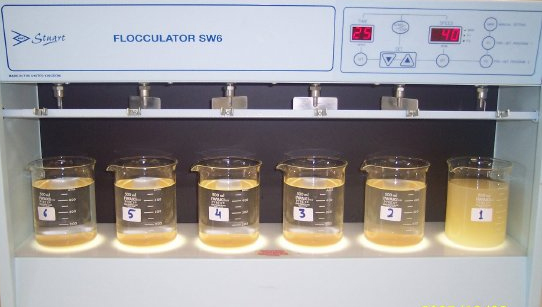
Figure 2. A traditional jar test device was owing for the treatment of turbid water
RESULTS AND DISCUSSION
Effectiveness of Dosage (CA) on Physicochemical Parameters
The results of the jar test at various Cicer. Arietinum concentrations (50, 30, and 20 mg/L). The optimum concentration of (CA) is 50 mg/L, which reduced turbidity from (97 to 93.16 %) and TSS from (110 to 55.6)
Effectiveness of Various pH Values
The coagulation achievement of Cicer arietinum for reducing turbidity in wastewater preferred the acidic condition; in this experiment, the variation in pH was applied from (3-10), which works best at pH=3, we noticed that the water appeared clearer and the flocs were observed after the settling process, but when the pH increased more than 6 the water turned cloudier and fewer flocs were found and gave lower turbidity % at pH=10 because the conditions turned alkaline, all these data were noticed in Figure (3).
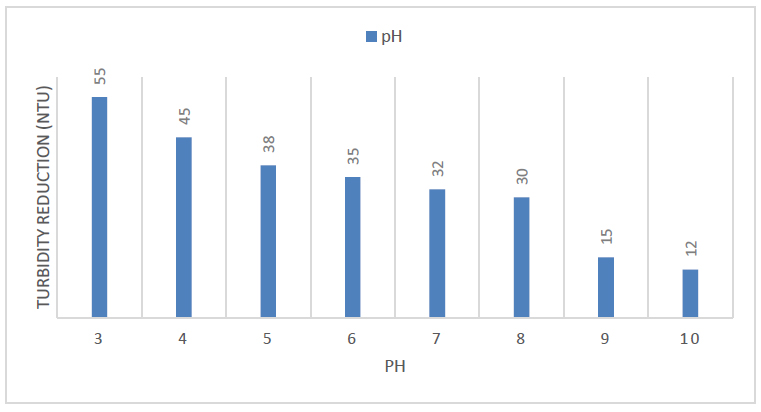
Figure 3. Turbidity reduction at different pH of the wastewater
Reduction of Turbidity Using Different Doses of (CA)
Before we studied the effect of different doses on turbidity, the raw wastewater turbidity was found 97 NTU, using various Cicer Arietinum doses (50,60,70,80,90,100) mg/ L. It was observed that C. arietinum highly efficient to higher dosage and lower dosage, but increasing in dosage caused again increase in turbidity as shown in Figure (4).
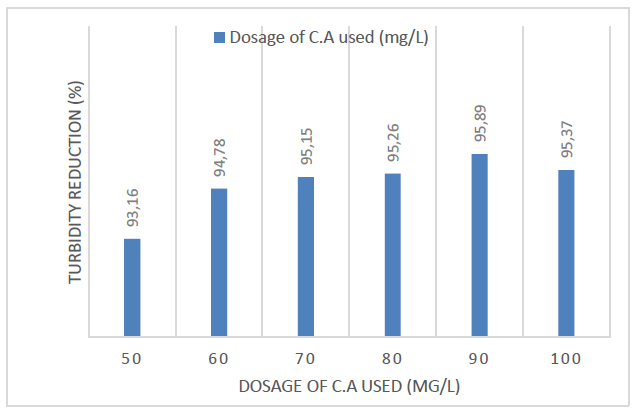
Figure 4. Elimination of turbidity using various dosages of Cicer Arietinum.
Effectiveness of Contact time on the turbidity ratio
In Figure (5), Different values of contact time were examined from (40 to 160 minutes). The test showed turbidity elimination raised when the time increased from 100 to 120 minutes, then decreased when the contact time was increased up to 120 minutes because the coagulant (CA) efficiency in absorbing the colloids decreased flocs were broken. So, from the previous study, further increase for mixing escalates micro flocs breakage in primary particles, slowing down floc's growth during flocculation 10. The highest turbidity removal was achieved at 120 minutes.
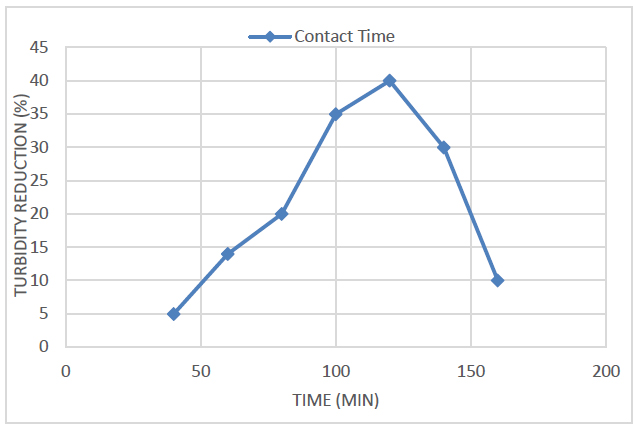
Figure 5. Shows the effects of various contact time on the efficiency of turbidity removal
The efficiency of Temperature on Turbidity Reduction
In this experiment, we used different temperature values were (25,30,35,40), which the optimum temperature for removal turbidity was 250C as observed in Figure (6), Which by increasing temperature, the turbidity removal efficiency decreased.
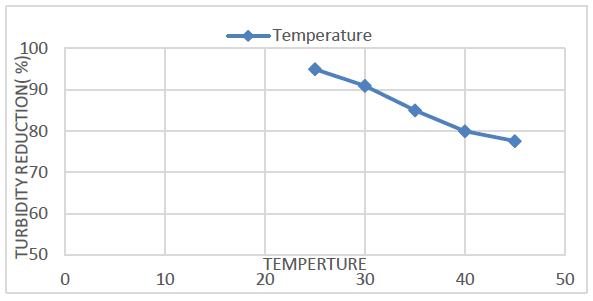
Optimization of Agitation Speed on Turbidity Reduction
Mixing speed is one of the most substantial roles for obtaining turbidity removal competence or failure of the flocculation, different values were used beginning from (20-140), So Figure 7 indicates that the high evaluation at 80 rpm with 95% removal. From the following data, we observed that this case was especially which by higher agitation speed, the turbidity removal efficiency became very weak and minimized to the flocs created in the coagulation-flocculation operation was facilely destroyed 13. A traditional flocculation unit operation contains three separate steps: 1-quick or flash blending: the convenient chemicals (flocculation and if required pH adjusters) are poured to the wastewater stream, stirred, and emphatically blended at rising speed. 2-Slow mixing (flocculation): the wastewater is only reasonably stirred to compose large flocs readily settled out. 3- Sedimentation: the floc created through flocculation is authorized to settle and is separated from the current flow 9,19, 21.
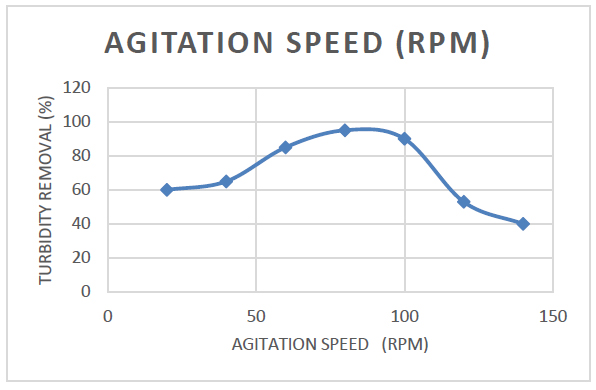
Figure 7. The influences of various mixing speeds on turbidity reduction
CONCLUSION
The application of natural coagulant (Cicer arietinum) on surface water treatment was checked in this research. The surface water was described by the concentration elevation of suspended particles. On varying the coagulant dosage, pH, and settling time, these particles get readily dissolved and settled along with the coagulants added 4 . Based on the fact that Cicer arietinum (CA) being the most economical and environment-friendly alternative natural coagulant, so we used it for removing colloids and decrease turbidity by jar test method instead of chemical coagulants which have inherent disadvantages affecting on human health, from the parameters that were discussed in the experiment as atrial to remove or decreased turbidity efficiency from wastewater (Mostourd refinery area), we reach to a result that the optimal dose of Cicer arietinum (CA) for higher efficiency of turbidity and color removal is 90 mg/L, with other constant parameters like (Temperature =250C, pH= 3, Contact time=120 min, and agitation speed for 2 minutes =80 rpm (rapid mixing), from These all other optimal water quality parameters have a very significant effect on improving turbidity reduction percentage by 95.89%. Since we have collected the wastewater from the outlet of Ismailia Canal (Mostourd refinery site) as a water source; we suggest that instead of using chemical coagulants that has Avery terrible side effects on health, we must and restricted on using natural coagulants like (Cicer arietinum (CA) as an alternative method for the treatment process.
REFERENCES
1- Ebeling, JM, Sibrell PL, Ogden SR, Summerfelt ST. Summerfelt Evaluation of chemical coagulation-flocculation aids for the removal of suspended solids and phosphorus from intensive recirculating aquaculture effluent discharge, Aquacultural Engineering. 29(2003) 23-44.
2- McGhee TJ, Water Supply and Sewerage. McGraw-Hill, New York, 260 (1991) 287.
3- Francois RJ, Ageing of aluminum hydroxide flocs, Water Research. 21(1987) 523-531.
4- Gunaratna KR, Garcia B, Andersson S, Dalhammar G, Screening and evaluation of natural coagulants for water treatment, Water Science and Technology .7(2007) 19-25.
5- AE Clecerils, Greenberg and Eaton AD, Standard Methods for the Examination of water and wastewater, 20th Ed. American Public Health Association, USA, Washington DC. (1998).
6- Diaz A, Rincon N, Escorihuela A, Fernandez N, Chacin E, Forster CF. A preliminary evaluation of turbidity removal by natural coagulants indigenous to Venezuela" 1999, Process Biochemistry. 35(1999) 391-395.
7- Cheremisinff NP, Hank Book of Water and Wastewater Treatment Technologies, An Overview of Water and Water Treatments. Butterworth-Heinemann Publication, 3 (2002)1-60.
8- Rowe DR, Abdel- Magid IH, Handbook of Wastewater Reclamation and Reuse, Boca Raton, Lewis. 3 (1995)167-181.
9- Apha, Standard Methods for Examination of water and wastewater, 17th Ed. Washington DC. 3(1) (1992) 501-517.
10- Metcalf, Eddy, Wastewater Engineering Treatment, Disposal and Reuse New York, McGraw Hill. 3(1991) 35-40.
11- Asrafuzzaman Md, Fakhruddin ANM, Alamgir Hossain Md. Reduction of Turbidity of Water Using Locally Available Natural Coagulants. International Scholarly Research Notices.10 (2011) 1-7.
12- Abdel-Kalek MA, Abdel Rahman MK, Francis AA. Experimental Design and Desirability Analysis for Optimizing the Bio-sorption of Liquid Paint-related Wastes onto Solid Eggshell Wastes. Environmental Processes. 7(2) (2020) 493-508.
13- Jaoudi M, Amdouni N, Coagulation Treatment by Al2 (SO4) 3 and Residual Al Determination in Medjerda Water Dam (Tunisia), Journal de la Société Chimique de Tunisia.15 (2013) 175-181.
14- Marey A, Synthesis Composite of Tio2/ Chitosan and Tio2 / Bentonite for removing turbidity from Ismailia Canal as Water Treatment Plant, African Journal of Chemical Education (AJCE). 10(1) (2020)124-134.
15- Jahn SAA, Using Moringa seeds as coagulants in developing countries, Journal of the American Water Works Association. 80 (1988) 43-50.
16- Yarar B, Evaluation of Flocculation and Filtration Procedures Applied to WSRC Sludge, Report no, DE-AC09-96SR 18500, Colorado School of Miness.34 (2001) 234-244.
17- Choubey S, Rajput SK, Bapat, KN. Comparison of Efficiency of some natural coagulants-Bioremediation. International Journal of Emerging Technology and advanced Engineering. 2 (2012) 159-168.
18- Rossini M, Garrido J, Garcia, Galluzzo M, Optimization of the coagulation-flocculation treatment influence of rapid mix parameters, Water Research. 33(8) (1999)1817-1826.
19- Babitha Merlin S, Abirami S, Suresh Kumar R. Studies on the treatment of surface water using rajma seeds. Journal of Civil Engineering, 10 (2018) 10-15.
20- Kawamura S, Effectiveness of natural polyelectrolytes in water treatment. Journal of the American Water Works Association, 83 (1991) 88-91.
21- Liu MM, The Effectiveness of the Natural Polymers Chitosan, Polyglutamic Acid, and Moringa Oleifera Seeds in Water Purification, California State Science Fair. 3(2014) 2-14.
Received: 16 March 2021
Accepted: 10 July 2021
Amera Marey Mohammed Hassanien (A.Marey)
ORCID: https://orcid.org/0000-0001-5667-4766
Department of Basic Science, The Valley Higher Institute for Engineering and Technology, Obour 11828, Egypt.
Email 1: [email protected]
Email 2: [email protected]
